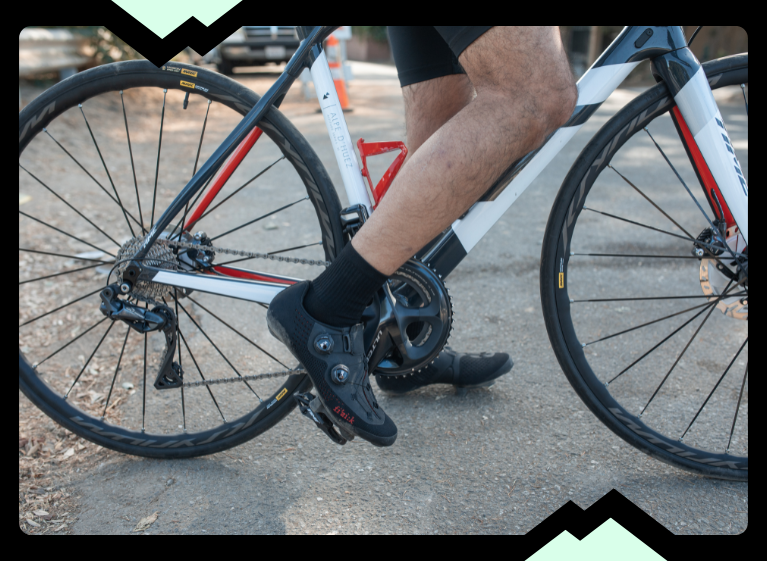10 Tips for Using Cycling Cleats and Clipless Pedals for The First Time
- Posted on
- By James @ 360 Cycles
- 0

After all, cycling without them would make you much slower. But with that said, using cycling cleats for the first time can be difficult and scary - here are some tips to help you if you're trying out this new piece of equipment.
Cycling has become a very popular and rewarding sport. However, it's impossible to get the full experience without cleats for your pedals. After all, cycling without them would make you much slower. But with that said, using cycling cleats for the first time can be difficult and scary - here are some tips to help you if you're trying out this new piece of equipment.
To help you out, I've compiled a list of the benefits and risks of cycling cleats and clipless pedals. First of all, the first thing you need to know is that there are two types of cleats: "clipless" and hybrid. Clipless cleats (like these ) attach to your shoe by clipping onto your toe-cap. The other type of cleat is called "hybrid", which does not require any special attachment like a clipless one.
To avoid any confusion:
The name clipless is a bit confusing and perhaps misleading. Clipless pedals do 'clip' to your shoes while flat pedals don't have a clip at all. They're called clipless because they don't have toe straps or cages.
Introduction to the clipless pedals and cycling cleats handbook
Cycling cleats and clipless pedals are an important part of any cyclist's gear, as they provide extra stability and grip when cycling. They also come with a range of benefits and risks, so it's important to understand both before making a purchase.
The benefits of cycling cleats include increased stability and grip while cycling and reducing the risk of injuries. This is because cycling cleats distribute weight evenly across the entire foot, which provides more support and prevents the foot from moving independently.
Cycling cleats and clipless pedals also increase your speed and endurance by helping you to ride longer distances without fatigue. However, cycling cleats and clipless pedals also have their own set of risks. These include wearing down your pedals over time, causing them to fail, and increasing the risk of leg injuries. It's important to take these risks into account before purchasing cycling cleats and clipless pedals so that you can make an informed decision.
Overshoes are also worth mentioning as they tie in with cycling cleats, they are worn for cold and wet weather foot protection. Getting wet and freezing isn't fun, so it's important to wear the right clothes when riding. Wearing overshoes rather than just cleats means your feet are in much better shape.
If the weather isn't wild enough to warrant overshoes, still ensure that you are wearing the correct socks. With these on, the fit of the shoe means it stays in place during your ride and promotes blood flow to the feet and legs, reducing the swelling that naturally occurs during cycling with the wrong socks on.
What are the benefits and risks of Cycling Cleats?
Cycling cleats and clipless pedals are devices that attach to cycling shoes and give the cyclist added support while cycling. They come in a variety of shapes, sizes, and materials, but all have one common goal - to increase the rider's stability and grip on the bike while cycling. While they may seem like a simple addition, Cycling cleats can provide several benefits and risks to cyclists.
The benefits of Cycling cleats include:
Increased stability while cycling at speed: Cycling cleats help to stabilise the cyclist's balance while cycling, which can help to prevent falls.
Increased grip on the bike: Cycling cleats add extra grip to the cyclist's pedals, which can help to improve your pedal stroke and increase your speed.
Increased speed: Cycling cleats can increase your speed while cycling. The more power transferred simply means more speed and faster times. The ability to pull up and push down on the pedal allows for a more circular pedal stroke, which should also spread the load over more muscle groups.
Some of the risks of cycling cleats:
• Cleats are often worn incorrectly, which can cause injury to the cyclist. The most common error is wearing them too high or at an angle, which can put unnecessary pressure on the rider's shins, knee joints, and ligaments. Wearing it too low can also cause injuries to the foot and ankle - especially when combined with a hard-soled shoe, such as mountain biking shoes.
• Difficulty getting used to clipping out: Many cyclists, particularly those starting out using cleats and clipless pedals can suffer injuries from falling off the bike due to not properly knowing how to 'clip in' and 'clip out' or from a lack of practising/coordination.
A report from a UK clinic was looking into hip fractures and concluded: 'cyclists who come to a stop and are attached to their pedals by straps or clips are likely to tumble with their bicycle and fall directly onto one or other hip, thus sustaining this kind of injury to the pelvis.
The importance of learning how to clip in and out of the pedals using cycling cleats
Cycling cleats and clipless pedals are important pieces of equipment for cyclists, and it's important to learn how to use them properly to stay safe and get the best use out of them. These cleats require extra pressure on certain surfaces and can be dangerous for inexperienced riders on uneven roads.
You can clip yourself into the pedal by sliding the front of the cleat under the catch on the pedal and pressing down hard with your heel.
When you clip in you will both hear and feel the latched engagement. To release the cleat from the clipless pedals, twist your heel out to the side, away from the bike and out it will pop. With some consistent practice, you'll be able to do this confidently.
Conclusion
Cycling cleats are a great way to increase your speed and improve your pedalling rhythm. They can also help you avoid injuries by providing more stability when you're cycling. However, as with any piece of sporting equipment, there are risks associated with cycling cleats. It's important to be aware of these risks and decide whether or not they are worth taking before purchasing or using them.
FAQ
-
Are cleats necessary for cycling?
The bike shoe is designed with a stiffer sole, perfect for an efficient and powerful pedal. The soles are popular among active cyclists because they provide an efficient transfer of power while they pedal. But, you can essentially cycle a bike with just about any kind of shoe.
-
What do you need for cycling cleats?
Clip-in pedals are composed of two main components: the pedal, which attaches to your bike like a regular flat pedal; and the cleat, which attaches to the sole of your cycling shoe. A spring mechanism on the pedal allows you to 'clip' into your shoes with ease.
-
What cleats do pro cyclists use?
The vast majority of pro cyclists who compete in pelotons rely on Shimano and Look because those brands sponsor most of the WorldTour, while some teams prefer to implement pedals that are all Shimano.
If you’ve got any questions about this blog, or Buy Cycling Cleats and Clipless Pedals for The First Time please get in touch. Our Sales Crew will be happy to guide you through every step.











Comments
Be the first to comment...